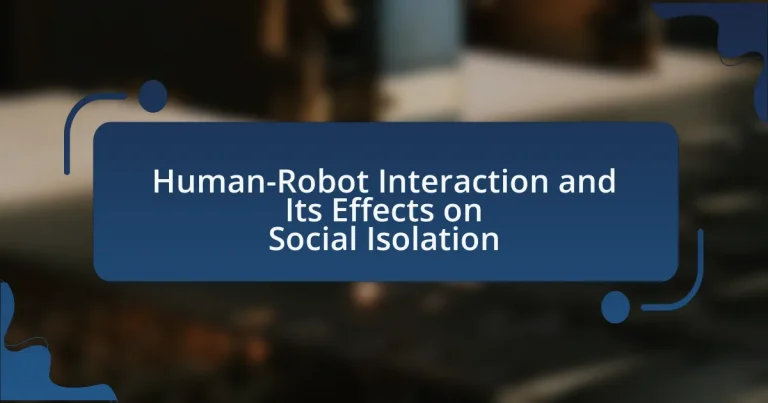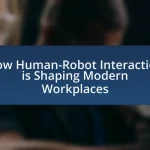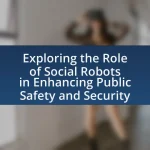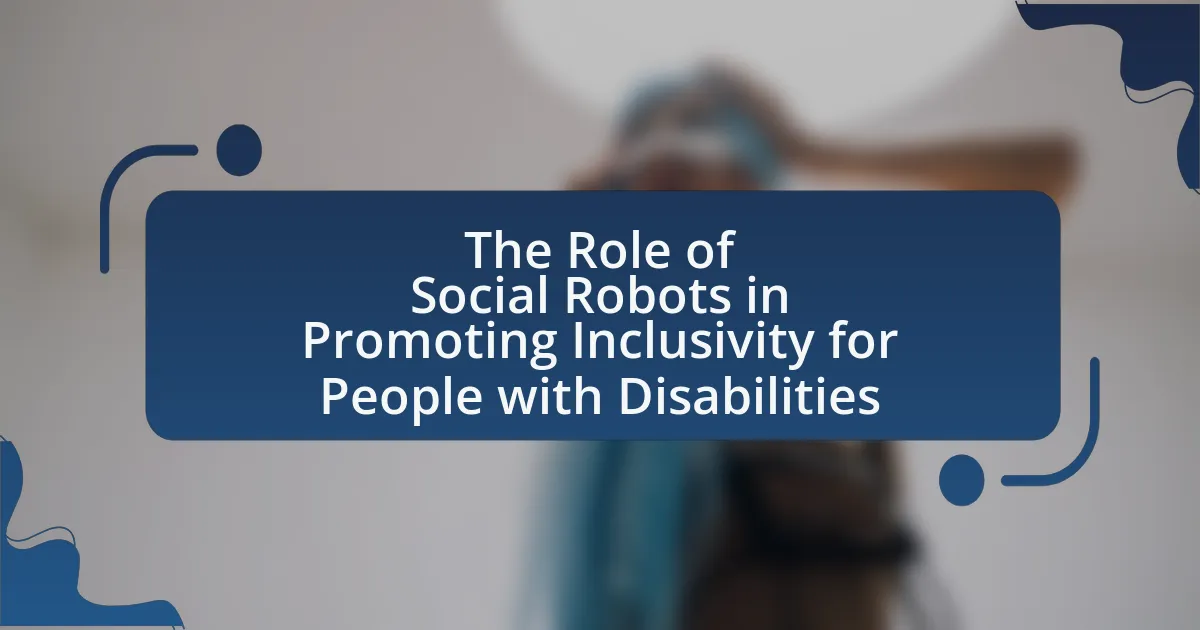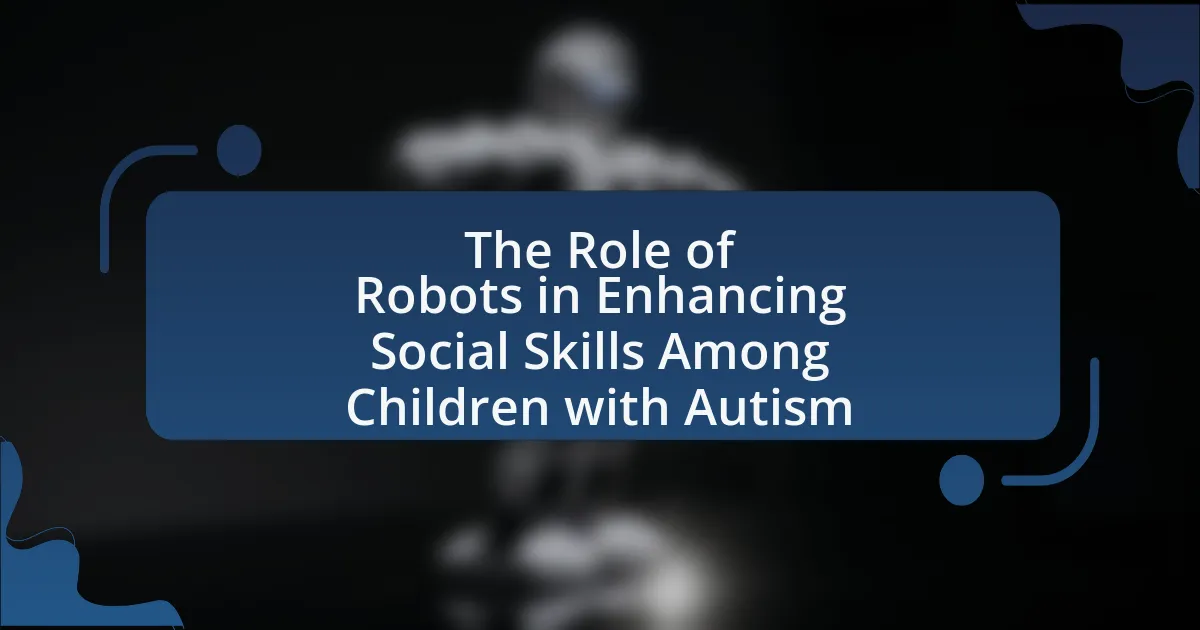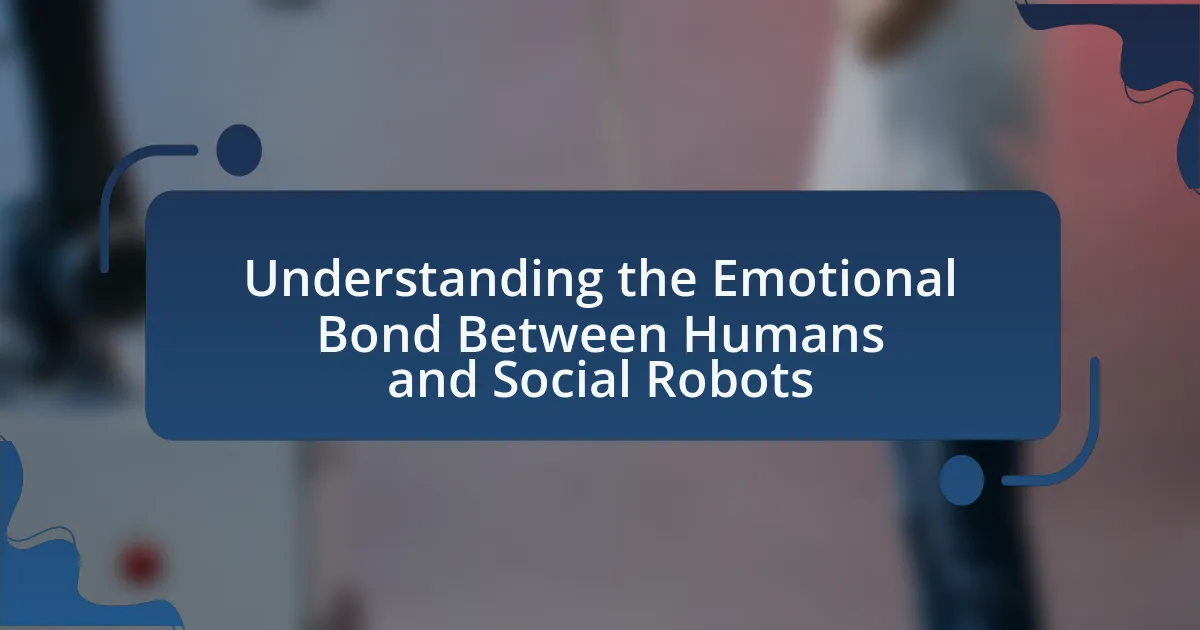Human-Robot Interaction (HRI) is an interdisciplinary field that examines how humans and robots communicate and collaborate, particularly in contexts aimed at reducing social isolation. The article explores the functioning of HRI in various environments, such as homes and healthcare facilities, highlighting the technologies involved, including artificial intelligence and emotion recognition. It discusses the psychological effects of HRI on socially isolated individuals, emphasizing the role of companion robots in enhancing emotional well-being and social engagement. Additionally, the article addresses ethical considerations and best practices for responsible robot use, underscoring the potential impacts of robotic companionship on human relationships and social dynamics.
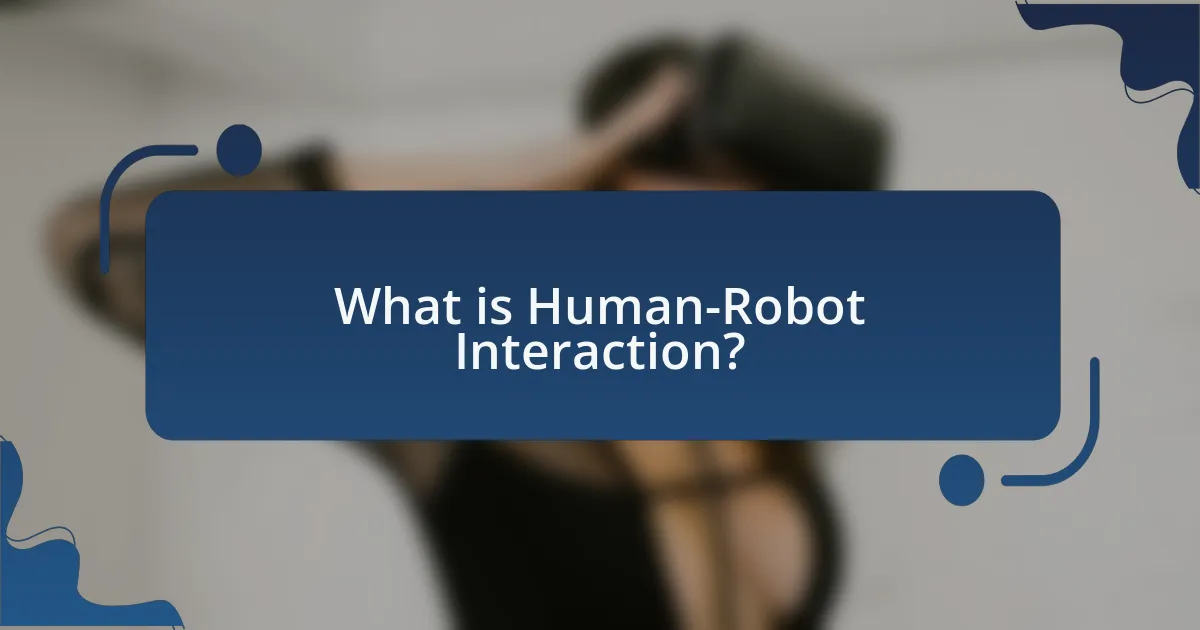
What is Human-Robot Interaction?
Human-Robot Interaction (HRI) refers to the interdisciplinary field that studies the interactions between humans and robots. This field encompasses various aspects, including the design, implementation, and evaluation of robotic systems that can effectively communicate and collaborate with humans. Research in HRI has shown that effective interaction can enhance user experience and improve the functionality of robots in social settings, as evidenced by studies demonstrating that robots can assist in reducing feelings of loneliness and social isolation among individuals, particularly the elderly.
How does Human-Robot Interaction function in various environments?
Human-Robot Interaction (HRI) functions by enabling robots to communicate and collaborate with humans across diverse environments, such as homes, healthcare facilities, and workplaces. In domestic settings, robots assist with daily tasks and provide companionship, which can reduce feelings of loneliness and social isolation. In healthcare environments, robots facilitate patient monitoring and rehabilitation, enhancing emotional support and interaction, thereby improving mental well-being. In workplaces, robots can collaborate with humans on tasks, increasing productivity and fostering social connections among employees. Research indicates that effective HRI can lead to improved social engagement and reduced feelings of isolation, as evidenced by studies showing that elderly individuals interacting with companion robots report higher levels of social satisfaction and lower levels of loneliness.
What technologies are involved in Human-Robot Interaction?
Human-Robot Interaction involves several key technologies, including artificial intelligence, machine learning, natural language processing, computer vision, and robotics. Artificial intelligence enables robots to process information and make decisions, while machine learning allows them to improve their performance over time through experience. Natural language processing facilitates communication between humans and robots, enabling understanding of spoken or written language. Computer vision provides robots with the ability to interpret visual information from their environment, enhancing their interaction capabilities. Robotics encompasses the physical design and movement of robots, allowing them to perform tasks and engage with humans effectively. These technologies collectively enhance the functionality and effectiveness of robots in social contexts, addressing issues related to social isolation.
How do robots perceive and respond to human emotions?
Robots perceive and respond to human emotions primarily through sensors and algorithms designed for emotion recognition. These systems utilize techniques such as facial recognition, voice analysis, and physiological monitoring to interpret emotional cues. For instance, research by Picard et al. (2004) in “Affective Computing” demonstrates that robots can analyze facial expressions and vocal tones to identify emotions like happiness or sadness. Once emotions are detected, robots can respond appropriately, either through verbal communication or non-verbal gestures, enhancing social interaction. This capability is crucial in applications aimed at reducing social isolation, as robots can provide companionship and emotional support, thereby improving the well-being of individuals, particularly the elderly.
What are the key components of Human-Robot Interaction?
The key components of Human-Robot Interaction (HRI) include perception, communication, and collaboration. Perception involves the robot’s ability to sense and interpret human actions and emotions, which is crucial for effective interaction. Communication encompasses both verbal and non-verbal exchanges between humans and robots, facilitating understanding and engagement. Collaboration refers to the ability of humans and robots to work together towards common goals, enhancing task efficiency and user experience. These components are essential for creating effective and meaningful interactions that can mitigate social isolation by fostering companionship and support through robotic systems.
What roles do sensors and actuators play in Human-Robot Interaction?
Sensors and actuators are critical components in Human-Robot Interaction, enabling robots to perceive their environment and respond appropriately to human actions. Sensors collect data from the surroundings, such as visual, auditory, and tactile information, allowing robots to interpret human behavior and contextual cues. For instance, cameras and microphones help robots recognize faces and voices, facilitating more natural interactions. Actuators, on the other hand, translate the robot’s decisions into physical actions, such as moving limbs or producing sounds, which are essential for engaging with humans effectively. The integration of these technologies enhances the robot’s ability to assist, communicate, and provide companionship, thereby potentially reducing feelings of social isolation in users.
How does artificial intelligence enhance Human-Robot Interaction?
Artificial intelligence enhances Human-Robot Interaction by enabling robots to understand and respond to human emotions and behaviors effectively. This capability allows robots to engage in more natural and intuitive interactions, fostering a sense of companionship and reducing feelings of social isolation. For instance, AI algorithms can analyze facial expressions, voice tones, and body language, allowing robots to adapt their responses accordingly. Research has shown that robots equipped with AI can improve emotional well-being in individuals, particularly the elderly, by providing social support and companionship, which is crucial in mitigating loneliness.
What are the potential impacts of Human-Robot Interaction on social dynamics?
Human-Robot Interaction (HRI) can significantly alter social dynamics by influencing communication patterns, emotional connections, and social behaviors among individuals. For instance, studies have shown that robots can enhance social engagement, particularly among isolated individuals, by providing companionship and facilitating interactions that might not occur otherwise. Research published in the journal “Social Robotics” indicates that elderly individuals who interacted with social robots reported increased feelings of companionship and reduced loneliness, demonstrating that HRI can positively impact social well-being. Additionally, HRI can shift social norms and expectations, as people may begin to view robots as social agents, which can lead to changes in how humans interact with one another.
How can Human-Robot Interaction reduce feelings of loneliness?
Human-Robot Interaction can reduce feelings of loneliness by providing companionship and social engagement through interactive communication. Robots designed for social interaction, such as companion robots, can engage users in conversation, respond to emotional cues, and offer support, which can alleviate feelings of isolation. Research indicates that individuals, particularly the elderly, experience improved emotional well-being and reduced loneliness when interacting with robots, as these interactions can mimic social relationships and provide a sense of connection. For instance, a study published in the journal “Social Robotics” by K. Wada and T. Shibata found that elderly participants reported lower loneliness levels after regular interactions with a robotic pet, demonstrating the potential of robots to fulfill social needs.
What are the risks of over-reliance on robots for social interaction?
Over-reliance on robots for social interaction can lead to significant risks, including social isolation, diminished emotional intelligence, and impaired human relationships. When individuals substitute human contact with robotic interaction, they may experience a decline in social skills and empathy, as evidenced by studies indicating that face-to-face communication fosters emotional understanding and connection. Research published in the journal “Computers in Human Behavior” highlights that excessive interaction with robots can exacerbate feelings of loneliness and reduce the quality of interpersonal relationships, as individuals may become less adept at navigating complex social cues and emotional nuances inherent in human interactions.
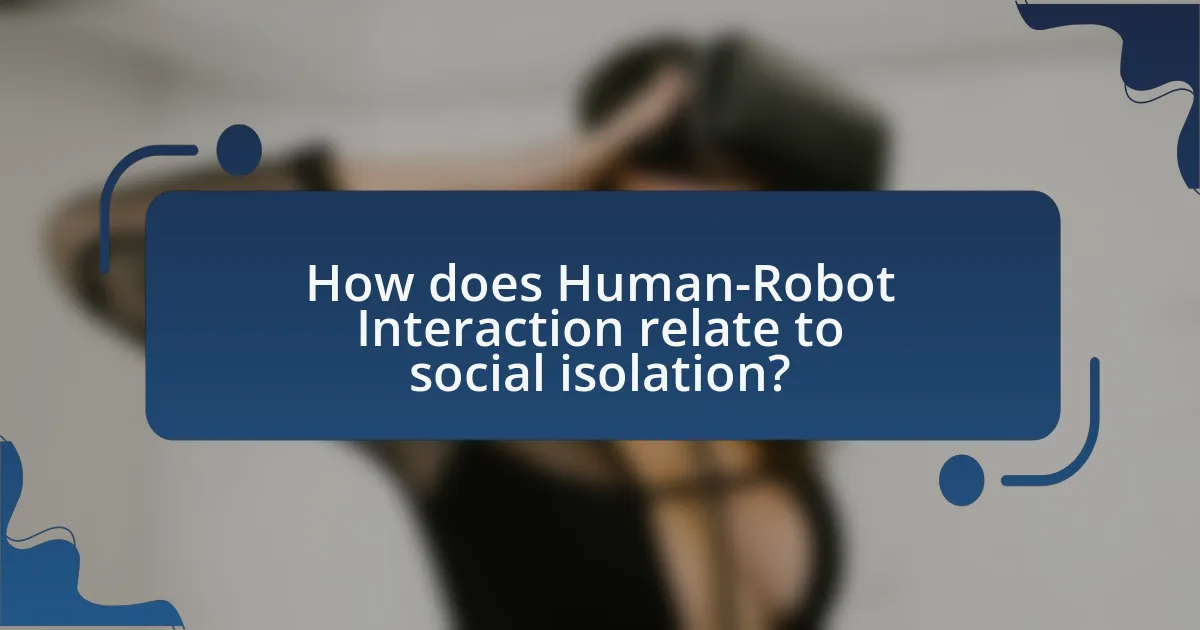
How does Human-Robot Interaction relate to social isolation?
Human-Robot Interaction (HRI) can mitigate social isolation by providing companionship and social engagement for individuals, particularly the elderly or those with limited social networks. Research indicates that robots can serve as social agents, offering emotional support and facilitating communication, which can reduce feelings of loneliness. For example, a study published in the journal “Social Robotics” by K. Wada and T. Shibata found that interactions with therapeutic robots significantly improved the emotional well-being of elderly participants, demonstrating a direct link between HRI and reduced social isolation.
What is the relationship between social isolation and technology use?
The relationship between social isolation and technology use is complex, as technology can both alleviate and exacerbate feelings of isolation. On one hand, technology, such as social media and communication apps, enables individuals to connect with others, potentially reducing feelings of loneliness. For instance, a study published in the American Journal of Preventive Medicine found that individuals who engage in online social interactions report lower levels of perceived social isolation. Conversely, excessive reliance on technology for social interaction may lead to decreased face-to-face communication, which can increase feelings of isolation. Research from the Pew Research Center indicates that heavy social media users often report higher levels of loneliness compared to those who engage in more direct social interactions. Thus, while technology has the potential to foster connections, it can also contribute to social isolation when it replaces in-person interactions.
How can Human-Robot Interaction serve as a tool for combating social isolation?
Human-Robot Interaction can serve as a tool for combating social isolation by providing companionship and facilitating social engagement for individuals, particularly the elderly or those with limited mobility. Robots designed for social interaction can engage users in conversation, play games, and remind them of important tasks, thereby reducing feelings of loneliness. Research indicates that social robots can improve emotional well-being; for instance, a study published in the journal “Gerontechnology” found that elderly participants reported increased feelings of companionship and reduced loneliness after interacting with social robots. This evidence supports the effectiveness of Human-Robot Interaction in addressing social isolation.
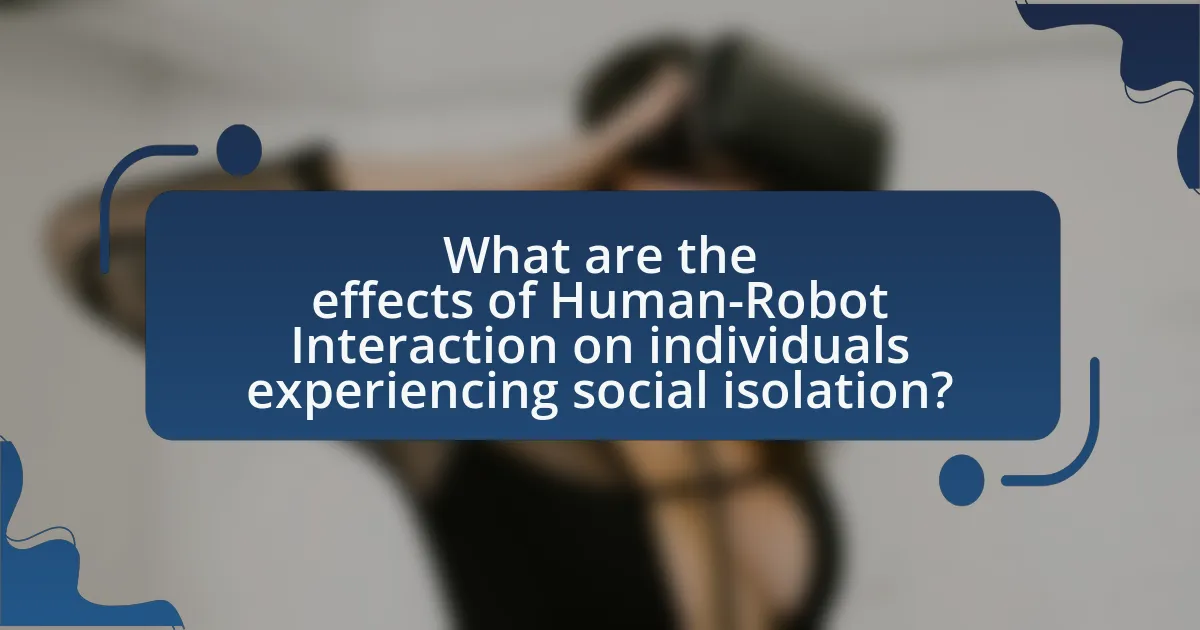
What are the effects of Human-Robot Interaction on individuals experiencing social isolation?
Human-Robot Interaction (HRI) positively affects individuals experiencing social isolation by providing companionship, reducing feelings of loneliness, and enhancing emotional well-being. Research indicates that social robots can engage users in meaningful conversations and activities, which can lead to improved mood and social connectedness. For instance, a study published in the journal “Social Robotics” by F. P. de Graaf and A. A. M. Allouch found that interactions with social robots significantly decreased loneliness levels among older adults. Additionally, HRI can stimulate cognitive functions and encourage physical activity, further contributing to the overall mental health of isolated individuals.
How do robots provide companionship to isolated individuals?
Robots provide companionship to isolated individuals by engaging them in conversation, offering emotional support, and facilitating social interaction. These robots, equipped with artificial intelligence, can recognize and respond to human emotions, creating a sense of connection. For instance, studies have shown that social robots like Paro, a therapeutic robot seal, can reduce feelings of loneliness and improve mood among elderly individuals in care facilities. Research published in the journal “Gerontechnology” indicates that interactions with robots can lead to increased social engagement and improved mental well-being, demonstrating their effectiveness in alleviating social isolation.
What types of robots are most effective in reducing social isolation?
Companion robots are the most effective type of robots in reducing social isolation. These robots, designed to engage users through conversation, emotional support, and companionship, have shown significant positive impacts on mental well-being. For instance, studies have demonstrated that companion robots like Paro, a therapeutic robotic seal, can reduce feelings of loneliness and improve mood among elderly individuals in care facilities. Research published in the journal “Gerontechnology” indicates that interactions with such robots can lead to increased social engagement and a decrease in depressive symptoms among isolated populations.
How do users perceive the emotional support provided by robots?
Users generally perceive the emotional support provided by robots as beneficial, particularly in alleviating feelings of loneliness and enhancing emotional well-being. Research indicates that robots can offer companionship and empathetic responses, which users often find comforting. For instance, a study published in the journal “Social Robotics” by K. Wada and T. Shibata found that interactions with therapeutic robots significantly improved the mood of elderly participants, demonstrating that users value the emotional engagement these robots provide. Additionally, surveys reveal that many users appreciate the non-judgmental nature of robots, which allows for open expression of feelings, further reinforcing the perception of robots as effective emotional support systems.
What are the psychological effects of Human-Robot Interaction on socially isolated individuals?
Human-Robot Interaction (HRI) can significantly alleviate feelings of loneliness and improve emotional well-being in socially isolated individuals. Research indicates that interactions with robots can provide companionship, reduce anxiety, and enhance social engagement. For instance, a study published in the journal “Social Robotics” by F. P. de Graaf and A. M. Allouch found that socially isolated individuals reported increased feelings of social presence and emotional support when interacting with robots. Additionally, robots can facilitate communication and social skills, which are often diminished in socially isolated individuals, thereby promoting a sense of belonging and improving overall mental health.
How does interaction with robots influence mental health outcomes?
Interaction with robots can positively influence mental health outcomes by reducing feelings of loneliness and enhancing social engagement. Studies have shown that individuals, particularly the elderly, experience improved emotional well-being when interacting with social robots, as these interactions can provide companionship and stimulate cognitive functions. For instance, research published in the journal “Gerontechnology” by K. Wada and T. Shibata demonstrated that elderly participants reported lower levels of depression and increased social interaction after regular engagement with a robotic pet. This evidence supports the notion that robots can serve as effective tools for mitigating social isolation and promoting mental health.
What role does Human-Robot Interaction play in enhancing social skills?
Human-Robot Interaction (HRI) plays a significant role in enhancing social skills by providing individuals with opportunities for social engagement and communication practice. HRI systems, such as social robots, can simulate social interactions, allowing users to develop and refine their conversational abilities, emotional recognition, and non-verbal communication skills. Research has shown that individuals, particularly those with social anxiety or autism spectrum disorders, benefit from interactions with robots, as these interactions can reduce stress and create a safe environment for practicing social behaviors. For instance, a study published in the journal “Interaction Studies” by K. Dautenhahn and colleagues demonstrated that children with autism improved their social skills through structured interactions with robots, highlighting the effectiveness of HRI in fostering social development.
What ethical considerations arise from Human-Robot Interaction in the context of social isolation?
Ethical considerations in Human-Robot Interaction (HRI) concerning social isolation include the potential for dependency on robots for companionship, which may hinder human social skills and relationships. This dependency can lead to a diminished quality of life, as individuals may prioritize interactions with robots over meaningful human connections. Furthermore, issues of privacy arise, as robots often collect personal data to tailor interactions, raising concerns about data security and consent. Additionally, the design of robots may inadvertently reinforce stereotypes or biases, impacting users’ perceptions of social norms. These ethical implications necessitate careful consideration in the development and deployment of robots intended to alleviate social isolation.
How do we ensure that robots are used responsibly in social settings?
To ensure that robots are used responsibly in social settings, it is essential to establish clear ethical guidelines and regulations governing their design and deployment. These guidelines should prioritize user safety, privacy, and the promotion of positive social interactions. For instance, the IEEE Global Initiative on Ethics of Autonomous and Intelligent Systems provides a framework that emphasizes transparency, accountability, and the importance of human oversight in robotic systems. By adhering to such standards, developers and users can mitigate risks associated with social isolation and ensure that robots enhance rather than detract from human interactions.
What are the implications of replacing human interaction with robotic companionship?
Replacing human interaction with robotic companionship can lead to increased social isolation and diminished emotional well-being. Studies indicate that while robotic companions can provide some level of comfort and reduce feelings of loneliness, they lack the emotional depth and understanding inherent in human relationships. For instance, research published in the journal “Computers in Human Behavior” by Sherry Turkle highlights that reliance on robots for companionship can hinder the development of social skills and reduce face-to-face interactions, ultimately exacerbating feelings of isolation. Furthermore, the absence of genuine human empathy in robotic interactions may lead to a superficial sense of connection, failing to fulfill the complex emotional needs that human relationships satisfy.
What best practices can enhance the effectiveness of Human-Robot Interaction in reducing social isolation?
Best practices that enhance the effectiveness of Human-Robot Interaction in reducing social isolation include designing robots with empathetic communication capabilities, ensuring user-friendly interfaces, and personalizing interactions based on individual user preferences. Empathetic communication allows robots to recognize and respond to emotional cues, fostering a sense of companionship. User-friendly interfaces facilitate ease of use, encouraging more frequent interaction. Personalization, such as adapting conversation topics or activities to align with the user’s interests, significantly increases engagement and satisfaction. Research indicates that these practices lead to improved emotional well-being and reduced feelings of loneliness among users, as evidenced by studies demonstrating that personalized robotic companions can enhance social connectedness in elderly populations.
